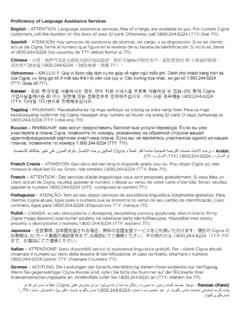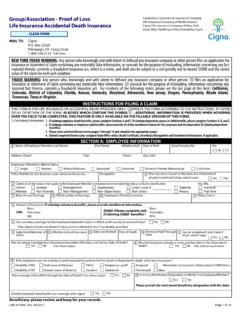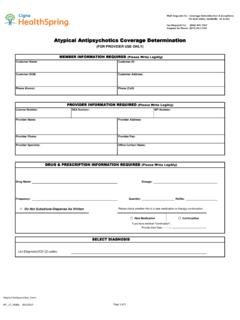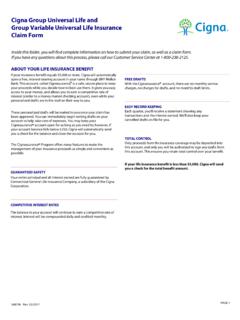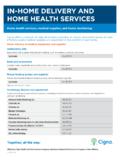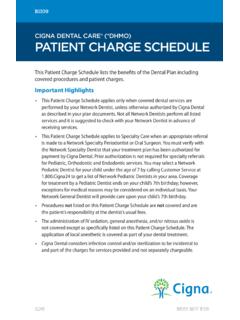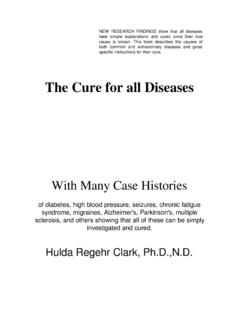Transcription of MAJOR NEUROCOGNITIVE DISORDER (MND): …
1 Provider s guide to diagnose and code Non-Reversible MND MAJOR NEUROCOGNITIVE DISORDER (MND): NON-REVERSIblE FORM Important change DSM-5 (2013) manual has renamed the term of dementia to MND; which expands the diagnostic criteria to include: Memory impairment Social cognitive dysfunction Complex attention derangement MND goes beyond dementia to include dysfunction in the following forms: Aphasia Inability to comprehend and express language Apraxia Inability to execute purposeful movements Agnosia Inability to recognize or process sensory information Executive function Inability to connect past experience with present action Mild cognitive impairment Mild cognitive impairment (MCI) is classified as between normal cognition and MND and is often an early form of MND.
2 Patients may exhibit: Intact activities of daily living Preserved cognitive function Objective memory dysfunction may be noted by family or friends such as: Inability to remember age, education or historical background Patients who express signs of aphasia, apraxia, agnosia, and Non-Reversible MNDs Alzheimer s disease (50-80% incidence) Diffuse cerebral cortical atrophy resulting in progressive mental and physical decline Etiology is unknown Common symptoms include change in mood, social withdrawal, confusion Vascular dementia (10-20% incidence) Caused by atherosclerotic plaques, which result in ischemic and/or infracted cerebral tissue executive function disturbances are no longer classified as MCI, but diagnosed as MND. Alzheimer s disease (AD) is the most common form of MND.
3 According to the Centers for Disease Control (2013): The risk of getting AD doubles every 5 years after the age of 65 25 to 50 percent of people exhibit some signs of AD after age 85 AD is the sixth leading cause of death in the Common symptoms are confusion, unsteady gait, and urinary incontinence Lewy-body dementia (5-10% incidence) Caused by deposition of alpha synuclein deposits in the outer cortex and mid brain These proteins are found in Parkinson s disease Falls/syncope and hallucinations are characteristic symptoms All Cigna products and services are provided exclusively by or through operating subsidiaries of Cigna Corporation, including Cigna Health and Life Insurance Company. The Cigna name, logos, and other Cigna marks are owned by Cigna Intellectual Property, Inc.
4 2015 Cigna INT_15_31319 07152015 ---- Non-Reversible MNDs (continued) Fronto-temporal dementia, previously known as Pick s complex (12-25% incidence) Focal asymmetric degeneration of the frontal and/ or temporal regions of the brain Manifests as progressive aphasia Patients may exhibit extrapyramidal symptoms Treatments for non-reversible MNDs seek to address the neurotransmission chemical pathology with: Medications which decrease but do not eliminate the progression of MND Wellness promoting activities such as: Exercise Healthy diet Active social engagement Intellectual participation ICD-10-CM codes to support a more precise diagnosis Documentation In addition to the objective examination it is important to document behavioral disturbances such as: Sleep disturbance Aggression Agitation Hallucination Delusion Wandering It is important to: Include findings that support a diagnosis of MND Ensure that a treatment plan and follow-up are included Confirm a face to face encounter is signed and dated by a credentialed provider Include specific ICD-10 code with written description 2015 ICD 10 CM ICD-10 CM Code ICD 10 CM Description Definition/tips Alzheimer s disease w/early onset Use additional code to identify.
5 Delirium, if applicable (F05) Dementia with behavioral disturbance ( ) Dementia without behavioral disturbance ( ) Alzheimer s disease w/late onset Other Alzheimer s disease Alzheimer s disease, unspecified Pick s Disease Primary progressive aphasia Progressive isolated aphasia Use additional code to identify: Dementia with behavioral disturbance ( ) Dementia without behavioral disturbance ( ) Other Frontotemporal dementia Frontal Dementia Dementia with Lewy bodies Dementia with Parkinsonism Lewy body disease Lewy body dementia Vascular dementia without behavioral disturbance Vascular dementia as a result of infarction of the brain due to vascular disease, including hypertensive cerebrovascular disease (includes arteriosclerotic dementia) Code first the underlying physiological condition or sequelae of cerebro vascular disease Vascular dementia with behavioral disturbance Evaluation It is important to interview the patient along with an informant.
6 Clinician should ask about deficits with: Judgment Language Learning elementary tasks Reduced activity interest Handling finances Memory problems Appointments Days of week Specific or current year Examination An objective examination needs to include the results of NEUROCOGNITIVE testing such as: Mini-Mental State Exam: shared/etools_ Mini-Cog: PHQ-9: pdfs/02_PHQ-9 References CDC. (October, 2013). Dementia/Alzheimer s disease McDade, E. M. and Petersen, R. C. Mild cognitive impairment: Epidemiology, pathology, and clinical assessment. In: UpToDate, DeKosky, S. T. (Ed), UpToDate, Waltham, MA. Accessed on 11/20/2014, + cognitive+impairmentandselectedTitle=1~9 4 Randolph, C. Frontotemporal dementia: clinical features and diagnosis. In UpToDate, DeKosky, S.
7 T. (Ed), UpToDate, Waltham, MA. Accessed on 11/20/2014, com/contents/frontotemporal-dementia-cli nical-features-and-diagnosis?surce=searc hresultandsearch=Frontotemporal+dementia %3A+Clinical+features+and+diagnosi sandselectedTitle=1~150 Shadlen, M. and Larson, E. Evaluation of cognitive impairment and dementia. In UpToDate, DeKosky, S. T. (Ed), UpToDate, Waltham, MA. Accessed on 11/20/2014, resultandsearch=dementiaandselectedTitle =1~150
